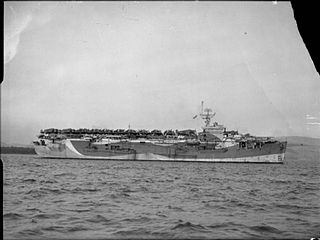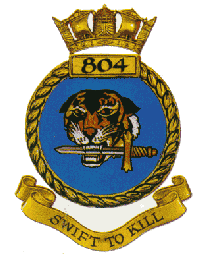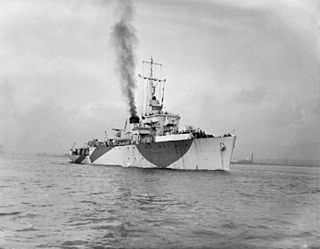
USS Bunker Hill was one of 24 Essex-class aircraft carriers built during World War II for the United States Navy. The ship was named for the Battle of Bunker Hill in the American Revolutionary War. Commissioned in May 1943 and sent to the Pacific Theater of Operations, the ship participated in battles in the Southwest Pacific, Central Pacific and the drive toward Japan through Iwo Jima and Okinawa, and air raids on the Japanese homeland.

HMS Ameer (D01) was an American escort carrier, the USS Baffins (CVE-35), that was transferred to the Royal Navy in mid-1943. As a Ruler-class escort carrier served in the Far East until the end of the war. Ameer was returned to the US Navy in 1946 and sold off to commercial service.

USS Jamaica (CVE-43), was an escort carrier of World War II that served in the British Royal Navy as HMS Shah (D21). Returned to the United States at war's end, she was converted into a merchant vessel and she was sold into civilian service in 1946 as Salta. She was ultimately scrapped in 1966.

The Grumman F4F Wildcat is an American carrier-based fighter aircraft that entered service in 1940 with the United States Navy, and the British Royal Navy where it was initially known as the Martlet. First used by the British in the North Atlantic, the Wildcat was the only effective fighter available to the United States Navy and Marine Corps in the Pacific Theater during the early part of the Second World War. The disappointing Brewster Buffalo was withdrawn in favor of the Wildcat and replaced as aircraft became available.

The Grumman F6F Hellcat is an American carrier-based fighter aircraft of World War II. Designed to replace the earlier F4F Wildcat and to counter the Japanese Mitsubishi A6M Zero, it was the United States Navy's dominant fighter in the second half of the Pacific War. In gaining that role, it prevailed over its faster competitor, the Vought F4U Corsair, which initially had problems with visibility and carrier landings.
This is a list of aviation-related events from 1945:

The Attacker class were a class of escort aircraft carriers in service with the British Royal Navy during the Second World War.

Operation Cockpit was an Allied attack against the Japanese-held island of Sabang on 19 April 1944. It was conducted by aircraft flying from British and American aircraft carriers and targeted Japanese shipping and airfields. A small number of Japanese ships and aircraft were destroyed, and one American aircraft was lost. While the attack was successful tactically, it failed to divert Japanese forces from other areas as had been hoped.

HMS Rifleman was a turbine-powered Algerine-class minesweeper of the Royal Navy. She was launched in 1943 and saw active service during World War II, both in the European and Far East theatres. After the war she served in the Mediterranean and was used as an accommodation ship in Barrow before being sold for breaking in 1972.

804 Naval Air Squadron was a Naval Air Squadron of the Royal Navy, formed in November 1939 from part of 769 NAS Sea Gladiators which had been detached to RNAS Hatston. The squadron was merged into 800 NAS in June 1944 and subsequently reformed in September.

On 15 August 1944, Allied forces carried out Operation Dragoon, a set of simultaneous amphibious landings by three US infantry divisions followed by four Free French divisions along the Mediterranean coast of France. The main landings were preceded by nighttime paratroop drops and commando beach landings. This was a phase of the European Theatre of World War II.

1700 Naval Air Squadron of the Fleet Air Arm of the Royal Navy was formed in November 1944 at RNAS Lee-on-Solent as an amphibian bomber reconnaissance squadron. It was equipped with the Supermarine Sea Otter, and the squadron joined HMS Khedive in January 1945 bound for Sulur in India. On arrival the Sea Otters were augmented with Supermarine Walrus amphibian aircraft.

HMS Vestal was a turbine-powered Algerine-class minesweeper of the Royal Navy. She was launched in 1943 and saw service in the Pacific War against the Empire of Japan. She was critically damaged by Japanese kamikaze aircraft in 1945 and was subsequently scuttled in waters close to Thailand.
Operation Mascot was an unsuccessful British carrier air raid conducted against the German battleship Tirpitz at her anchorage in Kaafjord, Norway, on 17 July 1944. Few of the British airmen were able to spot the battleship, and their attacks did not inflict any significant damage. Tirpitz was eventually disabled and then sunk by Royal Air Force heavy bombers later in the year.
Operation Balsam was a British naval operation in World War II, from 10–20 June 1945, under the command of Commodore Geoffrey Oliver. The third in a string of similar missions, the objectives were the naval bombardment and aerial strikes on Japanese airfields in Sumatra, Japanese vessels in the Strait of Malacca, and aerial reconnaissance.

Operation Collie was a British naval operation in World War II, from 5–11 July 1945. Its objectives were, firstly, naval bombardment and aerial strikes on Japanese positions in the Nicobar Islands, particularly on Nancowry Island; secondly, providing cover for minesweeping operations in advance of a possible invasion; and thirdly, making carrier raids on Japanese airfields in northern Sumatra. These measures were a prelude for an invasion, Operation Zipper, which was never carried out due to the Surrender of Japan.
Operation Robson was the first of a series of aerial operations, Operation Outflank, undertaken by the British Pacific Fleet (BPF) against the oil refineries of Japanese-occupied Sumatra during World War II. Admiral Chester Nimitz, Commander in Chief, Pacific Ocean Areas, proposed a strike on the refineries to Admiral Bruce Fraser, commander of the BPF, during a meeting in early December.

757 Naval Air Squadron was a Naval Air Squadron of the Royal Navy's Fleet Air Arm. It was first formed as a Telegraphist Air Gunner Training Squadron in 1939, operating out of RNAS Worthy Down, but after three months it went into abeyance, only to reform again in the same role, at the same location, in 1941 and operating until 1942. It then reformed as a Fighter Pool Squadron & Operational Training Unit at RNAS Puttalam, in Sri Lanka, in 1943. After a brief spell at RNAMY Tambaram, in India, the squadron finally disbanded at RNAS Katukurunda, in Sri Lanka, at the beginning of 1946.

On 20 November 1943, simultaneous landings were made by United States Marine Corps forces on Tarawa and United States Army forces on Makin, two coral atolls located in the Gilbert Islands chain in the South-Central Pacific.

For the April 1945 invasion of Okinawa, the Allies assembled the most powerful naval force in history. Since the few remaining capital ships of the Imperial Japanese Combined Fleet had been sunk or otherwise put out of action at the Battle of Leyte Gulf, the Allies were effectively unopposed in terms of major surface vessels; a single mission consisting of the superbattleship Yamato and a few escorts was undertaken, but the task force did not get within 200 nautical miles of the invasion area. The main Japanese naval opposition within the invasion area came from hundreds of Imperial Japanese Navy Shin'yō-class suicide motorboats and Maru-Ni Imperial Japanese Army attack boats.















